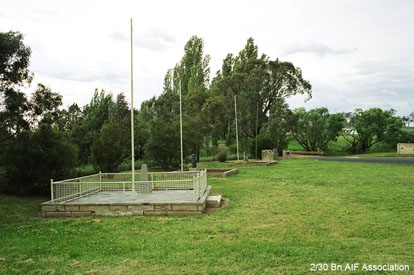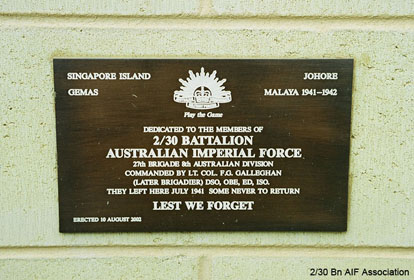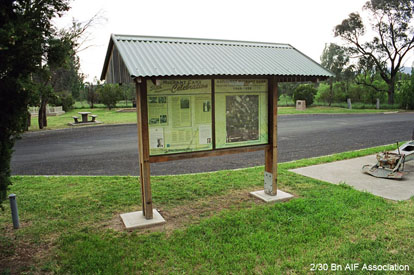|
Bathurst Army Camp, Kelso
|
Also
known as: |
Bathurst Army Camp -
1940-1947
Bathurst Migrant Camp (Bathurst Migrant Reception and Training Centre)
- 1948-1952
Rossmore Park
Bathurst Sheep and Cattle Drome |
|
Location:
|
Limekilns Road |
|
City/Town: |
Kelso |
|
State/Province: |
New South Wales |
|
Country:
|
Australia |
|
Directions: |
Turn into Boyd Street
at the intersection of Great Western Highway, Kelso. Boyd Street leads
into Limekilns Road. Continue for approximately 6km until you reach
the entrance of Rossmore Park. |
|
Sources |
Bathurst Visitors’
Centre Information Sheets “Bathurst Army Camp 1940-1947” and “Bathurst
Migrant Camp 1948-1952”. Research by Anthony Fisher, a student
in Applied History at Charles Sturt University. Additional photos by
2/30 Bn. Assoc. |
Find Bathurst Army Camp in
Google Maps
Notes
The camp was originally
built to accommodate the 1st Armoured Division. However, nearby farmers
opposed this idea as they could see tank manoeuvres disturbing grazing stock
and causing damage to the surrounding environment. When the army hierarchy
realised that tank exercises would be restricted, it was decided that the
camp would be an infantry training centre.
At the entrance of the
camp you will find memorials to the Army Units that trained in Bathurst.

Entrance to
Bathurst Army Camp. The
2/30 Battalion Cairn is in the foreground.
The flagpole which stood on the 2/30 Bn parade ground at
Bathurst has been erected at the memorial.

To the right of the
entrance are two sheds which were part of the old army camp.
Further along the road,
past the cattle grid on the right is where 'J' Block was once located. The
foundations you can see on your left are part of the Transport Depot and
Workshops.
The original barracks
were made from galvanised iron and had no insulation. The buildings were
iron sheds, wooden barracks and tents. On sunny days they were extremely hot
inside and at night freezing cold. The troops slept on palliasses, which are
hessian bags stuffed with fresh straw. During the cold winter months, the
soldiers were issued with four grey blankets and slept in 'long johns' under
their pyjamas, along with any other clothing that did not restrict their
breathing. However, the army was not always so tough on its men - during the
winter months, they were allowed to sleep in till 6.30am, instead of 6.00am!

Some of the buildings
when in use as Bathurst Migrant Camp
The camp was vast,
capable of holding 5,000 troops, and spread out along the main road with a
few arterial roads. Imagine how long it would take to walk from one end of
the camp to another. At the main office of the Sheep and Cattle Drome, there
is a map which shows the layout of the army camp.
At the time of the
Migrant Centre's closure in April 1952, the Bathurst and District Chamber
of Commerce reported that the Bathurst Reception and Training Centre had
grown to encompass:
“a fenced area of 3 1/2
square miles consisting of 11 self contained residential units (blocks)
capable of accommodating a total of just over 6,000 persons in reasonable
comfort.
Each of the 11 blocks
identified alphabetically from A to L, is equipped with a sufficient number
of hutments and barracks, the majority of which is subdivided into two room
quarters, a large number of toilets, shower recesses, washing and laundry
facilities, kitchens and dining halls and boiler houses supplying hot and
cold water.
The area is well
reticulated with water, and contains, apart from the 11 residential units
already mentioned, a fully equipped picture theatre with a voluminous stage
and ample additional rooms and storage space capable of seating an audience
of 1,800 persons; a separate transport department consisting of two large
vehicle halls and additional roofed space fully wired for power and light;
another unit that served for five years as a full time hospital capable of
housing up to 150 patients and personnel at a time; a first class post
office fully equipped with telegraph and telephone facilities and numerous
other structures.”

Surrounding Communities
This was not a holiday
camp and the troops spent most of the time camping outdoors. They went on
long route marches and carried out mock battles with each other. On many
winter mornings, troops on training exercises woke up to find their blankets
coated with thick, white frost.
While doing all this
training, they discovered the beauty of the Central West and were welcomed
by communities such as Blayney, Lithgow, Cowra and Orange.
Other features
At the top of the drive
where the Sheep and Cattle Drome is now located, only one building remains
from the old Army Camp. It is located behind the main office building. This
was the canteen, where the soldiers were able to purchase luxury items or
have a drink.
Out the back, on private
property today, appears to be a bunker, but it was actually used for grenade
throwing. Troops were positioned in the brick sheds at the end of the
double-brick wall, while a 'nervous' soldier, accompanied by an instructor,
threw what was probably his first grenade. Behind the wall, about 20 feet
back for safety purposes, is an observation post for another instructor.
Units that trained at
Bathurst
7th Division
The first soldiers to
arrive at Bathurst were elements of the newly formed 7th Division, which was
later to become the 9th Division. In the Middle East these men were
allocated to the 9th Division. The battalions included the 2/13 and 2/17
Infantry, with the 2/4 Anti-Tank Regiment. These units trained at Bathurst
from May to October, 1940.
8th Division
On the departure of the
Middle East contingent, new soldiers arrived at Bathurst. Elements of the
8th Division started to arrive in November 1940. This included the 2/18,
2/19 and 2/20 infantry battalions. By February 1941, they had been joined by
the 2/26, 2/29 and 2/30.

2/30 Battalion plaque on
the memorial wall at the entrance to Bathurst Camp
These soldiers
experienced a beautiful summer in the Central West which, in one way, suited
their overseas destination of Singapore.
A large aerial
photograph of the Migrant Camp, taken in 1954, is on display at the entrance
on Limekilns Road.

Information display
about Bathurst
Migrant Camp,
at the entrance to the Camp on Limekilns Road, Kelso
Back |